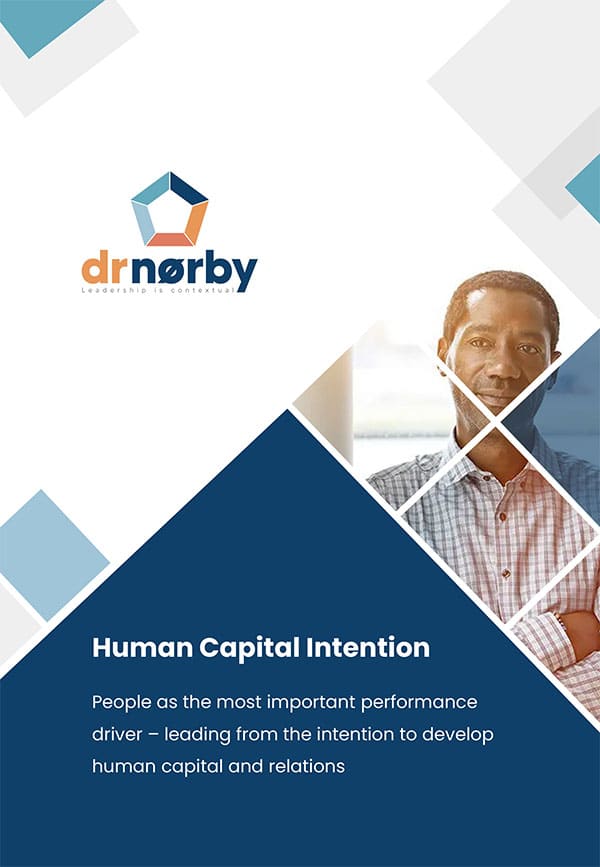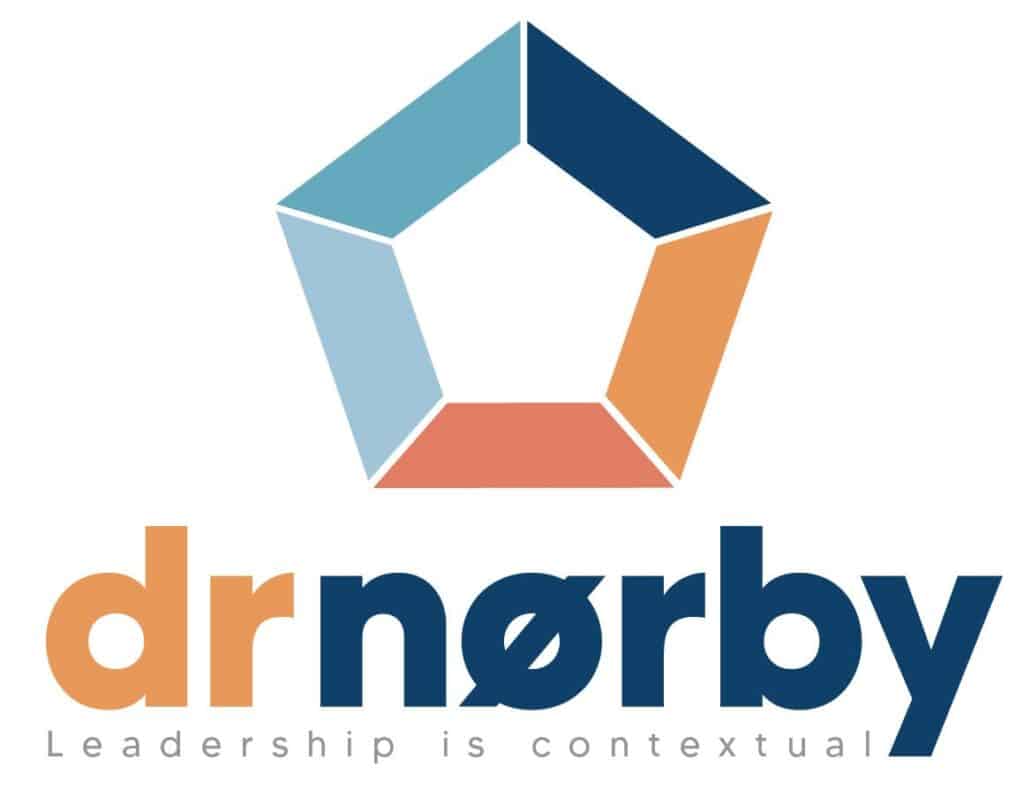
The organisational intentions which guide the leader on where they should spend their time
All organisations will have a combination of four main intentions, focused on the outcomes they want to achieve. The intention to improve human capital quality supports the other three intentions:
- Purpose fulfilment – the strength of the company’s purpose contributing to the greater good of society.
- Efficiency and stability – minimising operational costs and stabilising operations.
- Innovation and change – adapting to external or internal change demands and promoting innovation.
There are two sides of the human capital coin:
- An outside-in strategy where the leader is guided by the intention to enable the desired efficiency or innovation. Based on what the existing business operation needs, the leader works to acquire, develop and retain the right people and develop the most appropriate cultures for supporting performance.
- An inside-out strategy where the leader proactively builds the people capabilities to enable future aspirations. The approach is about building organisational capabilities to drive new value, enable new initiatives or drive step changes in the current performance. You recruit and develop your way to new avenues of performance.
The outside-in and inside-out strategies significantly influence recruitment, competence development, promotions, succession planning and culture development.
Why is the focus on human capital quality important?
There is a close relationship between the quality of human capital, organisational cultures and business performance. People, their capabilities and relations are the key performance drivers in any organisation. Leaders must identify which people composition lays the foundation for optimal performance and recruit, staff and rotate to make the optimal match between tasks and people. They should then decide which ways of working and collaboration should be promoted by shaping strong cultures to release the potential of the people. Getting this right is at the heart of effective leadership.

What leadership and team behaviours are needed?
-
Staffing. Recruiting the right people who bring the competencies, personalities, values and attitudes that fuel performance and organisational and team citizenship is crucial. For many leaders, this is a long-term success factor, and any vacancy should be considered an opportunity for optimising the people-base to secure future performance.
- People and team development. The leader must translate the human capital intentions into appropriate individual development plans and training, supported by remuneration and reward schemes. Another significant performance driver is considering how the existing staff is best matched to tasks and deliberately rotating tasks and people to optimise performance.
- The leader should focus on building high-quality relations. The leader can strengthen their leadership context by building solid relations among and between their teams and between themselves and their followers. High-quality relations are a driving force in strengthening cultures and increasing engagement and performance. High-quality relations directly translate into strong organisational citizenship, better talent attraction and higher retention.
Some opportunities and challenges of focusing on human capital quality
There is considerable overlap with the organisation’s human resource strategy. HR-led activities help the leader secure their people’s ongoing development through yearly people dialogue and review cycles. HR can support talent development across departments, training interventions and recruitment. HR can, however, never take over the responsibility for developing optimal human capital quality and relations as this is the most crucial performance driver for leaders.
High-quality relations trigger efforts that are ‘above and beyond’ and support more team citizenship and stronger team cohesion. Team members that shift from ‘doing my thing’ to ‘doing our thing’ deliver better performance. A stronger sense of belonging and well-established common ground is vital to a strong team. Common ground is the shared language, awareness and agreement about ‘how we do things around here’. It is the combination of strong cultures that comes together as a shared team foundation. Solid common ground combined with tolerance to diversity is necessary to benefit from diversity. The diversity that rests upon good quality relations and strong common ground yields above-average performance.
If the relationships in a team aren’t strong, the performance will be lower, especially in diverse teams. Diversity without team cohesion hinders performance, which underlines the importance of relationship quality as a performance enabler. Any team with low cohesion will have a harder time collaborating effectively. People tend to head toward different goals and focus on safeguarding themselves in such a team.
More on the power of high-quality relations
Team cohesion means people are more responsive to their leader’s influence and willing to renegotiate their assumptions and beliefs. This leads to an openness to divergence and diversity, which is the pathway to benefit from different perspectives. In many organisations, there will be minority views. The leader should encourage sharing different perspectives when opportunities and challenges are discussed. It improves the decision quality and supports more idea generation and creative problem-solving. The early phase of decision-making, problem-solving or development is about ensuring everyone and their differing perspectives are heard and included in the shared thinking. At the same time, high-quality relations mean the team can have constructive conflicts and productive discussions. Team cohesion also drives the feature of disagreeing in the opening phase and yet progressing to agreement and commitment in the closing phase. The cohesion also enables more shared leadership where team empowerment builds, and the team gradually takes over deciding and keeping each other accountable.

Contextual factors for a leader to shape
My doctoral research revealed the following advice for leaders on how they can affect their leadership context to maximise human capital quality and performance:
- Your authenticity, consistency and tolerance are some of the most significant factors in building team trust. Be clear on your expectations, how you interact and go about your work to lay an important foundation for building strong, trusting relations with your followers.
- Keep promises and role model the behaviour you expect from others. Deliver transparent decision-making and self-disclosure by openly sharing values, beliefs, thoughts and feelings. Reflect with your team to create trust and psychological safety.
- Display care and attention to your people. Practical considerations include being generally responsive and available to the team so they can always be confident of your support.
- Develop active followership and shared leadership. Hold recurring discussions around value creation and work-life issues that your team can contribute to and influence, resulting in outcomes where they can hold each other accountable.
- Focus on the exchanges between people. Your facilitation of meetings and interactions will set standards for communication – the tone, ensuring everyone feels able to make their voices heard, recognising and valuing the input.
- Relationships are built through meaningful participation in matters that matter! You build high-quality relationships by involving people in important prioritisation, decision-making and problem-solving. The cohesion builds when you develop shared standards for supporting diverse contributions, listening, managing disagreement, compromising, committing and keeping each other accountable. Strong relations are built through meaningful collaboration.
This mini-series contains four blogs on how organisational intentions should guide leadership. The other three blogs look at the intentions to fulfil purpose, innovate and succeed with change, and efficiency and stability.
This blog series is based on my doctoral research studies into the leadership context, involving more than 125 leadership experts. My research identified contextual factors that can significantly help or hinder leadership or organisational performance. It also gave me insight into the contextual dynamics and how to handle these challenges.
My blogs aim to inspire leaders to exercise more effective contextual leadership, and assist companies and consultants in developing better recruitment, leadership and talent programmes. Please get in touch if you have ideas, queries or wish to contribute to promoting insights about context and leadership.
Sign up to my newsletter and receive the e-book "Human Capital Intention"



